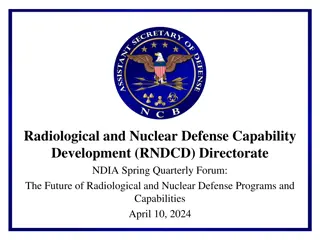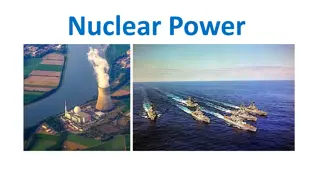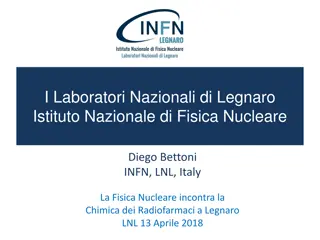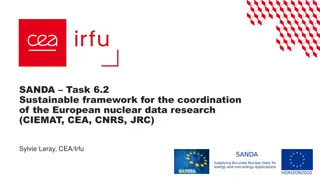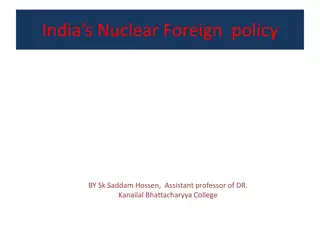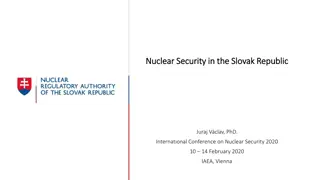Project SAMOFAR: Coordination and Scientific Exploration in Nuclear Safety
Project SAMOFAR involves a consortium led by scientific coordinator Jan Leen Kloosterman and manager Karin van der Graaf from TU Delft. The project focuses on integral safety, system integration, safety analysis, shut-down concepts, and more. Work packages include evaluating nuclide inventory, coupling reprocessing efficiencies with neutronics, and assessing re-criticality issues. CNRS, ITU, CEA, and other partners collaborate on tasks related to chemical plant design, reprocessing schemes, extraction efficiency studies, and criticality calculations.
Download Presentation

Please find below an Image/Link to download the presentation.
The content on the website is provided AS IS for your information and personal use only. It may not be sold, licensed, or shared on other websites without obtaining consent from the author.If you encounter any issues during the download, it is possible that the publisher has removed the file from their server.
You are allowed to download the files provided on this website for personal or commercial use, subject to the condition that they are used lawfully. All files are the property of their respective owners.
The content on the website is provided AS IS for your information and personal use only. It may not be sold, licensed, or shared on other websites without obtaining consent from the author.
E N D
Presentation Transcript
Projet SAMOFAR Coordinateur scientifique : Jan Leen Kloosterman (TU DELFT) Manager : Karin van der Graaf (TU Delft) WP1 : Integral safety approach and system integration E. Merle (CNRS/IN2P3/LPSC) WP2 : Physical and chemical properties required for safety analysis O. Benes (JRC) WP3 : Experimental proof of shut-down and decay heat removal concepts M. Ricotti (CIRTEN) WP4 : Accidental Transients D. Lathouwers (TU Delft) WP5 : Safety evaluation of the chemical plant S. Delpech (CNRS/IN2P3/INO) WP6 : Training, education and dissemination of results J.L. Kloosterman (TU Delft) WP7 : Project management K. Van der Graaf (TU Delft) Atelier MSFR, AREVA-Lyon, f vrier 2017 S. Delpech
Principal objectif du WP5 Etudier de la chimie du traitement du sel combustible, proposer un design pour l unit de retraitement et tudier les besoins en s ret de l unit . Partenaires du WP5: - CNRS - ITU - CEA - CINVESTAV Atelier MSFR, AREVA-Lyon, f vrier 2017 S. Delpech
Schma de traitement Mati re fissile, Np et d chets Etape 1 Fluoration d chets Bullage de gaz Etape 3 d chets D sextraction Ln dans LiCl-LiF et pr cipitation Ln2O3 Xe, Kr, M taux nobles Extraction U, Np, Pu, I, Tc, Te Nb, Mo, Se Etape 2.B Etape 2.A C ur du r acteur Extraction r ductrice Ln (Bi-Li2) Extraction r ductrice An (Bi-Li1) LiF-ThF4-(UF4-UF3) Etape 5 Etape 2.C D sextraction An dans LiF-ThF4 propre Etape 4 R g n ration de la composition des sels et des phases m talliques Contr le du potentiel redox et composition U/Th Atelier MSFR, AREVA-Lyon, f vrier 2017 S. Delpech
WP5 Task 5.1 Evaluation of nuclide inventory at various stages in the chemical plant (CNRS, ITU) A reprocessing scheme has been established in the EVOL project. The different steps have been validated both by bibliographic study and experimental determinations. The determination of the nuclide inventory at various stages of the chemical plant requires the knowledge of basic data such as activity coefficients and redox potential values. This task is dedicated to the determination of fundamental data such as activity coefficients both in metallic and salt phases (CNRS, ITU), the calculation of the separation/extraction efficiencies and the elemental inventory. The experimental validation of the reductive extraction between LiF-ThF4/Bi-Li will be done and the extraction kinetic will be studied for actinides (ITU) and lanthanides (CNRS). Atelier MSFR, AREVA-Lyon, f vrier 2017 S. Delpech
WP5 Task 5.2 Coupling of neutronic and reprocessing efficiencies (CNRS) The reprocessing efficiencies (Task 5.1) have to be coupled with the neutronics in order to determine the stage number of each reprocessing step, especially for the reductive extraction. The increase of the extraction stages can lead to an improve efficiency. The size of the chemical plant will depend on the number of stages. The fuel salt purity level (against fission products) required by neutronic calculations (realized in the WP1) helps to define a design for the chemical plant in relation with WP1 (CNRS). Task 5.3 Evaluation of Re-criticality issues (CNRS, CEA) Calculation of criticality based on the nuclide inventory to avoid fissile concentration in a part of the chemical plant (in relation with task 5.1) (CNRS, CEA). Atelier MSFR, AREVA-Lyon, f vrier 2017 S. Delpech
WP5 Task 5.4 Design and safety of the chemical plant (CNRS, CEA, ITU) The radioprotection of the chemical plant will be calculated based on the nuclide inventory at each stage of the reprocessing (in relation with task 5.1, 5.3 and 5.4) (CEA, CNRS, ITU). Two reprocessing steps require gas flows. The on-line reprocessing which consists in injection of He the reactor core to extract the gaseous fission products and the noble metal. Management of the gas and of the elements extracted by this step has to be studied from safety point of view. Calculations of residual heat, radioactivity decrease in the tanks and size of the tanks have to be performed (CNRS, CEA). The second step which requires gas flow is the fluorination step. Fluorine is injected in the molten salt to extract U, Np and several FP. The gas extracted is adsorbed on NaF traps heated at different temperatures to perform the separation. The gases are separated and reduced by reaction with hydrogen gas. The separation efficiency of this step will be determined based on the experimental feedback from ORNL available. Atelier MSFR, AREVA-Lyon, f vrier 2017 S. Delpech
WP5 Task 5.5 Material issues (CNRS, CINVESTAV)and KI (collaboration) The compatibility of materials in the several structures of the chemical plant will be assessed in this task. Recommendations on the material structure will be given especially for the fluorination plant, the reductive extraction line and the lanthanide oxide precipitation tank. Ni-based alloys with ZrO2coatings will be studied to evaluate their compatibility with non active fluoride molten salts (CINVESTAV) and active salts (CNRS). For compatibility with liquid Bi pools, studies to evaluate the resistance of Mo will be done (CNRS, KI). Atelier MSFR, AREVA-Lyon, f vrier 2017 S. Delpech
Mthodologie Atelier MSFR, AREVA-Lyon, f vrier 2017 S. Delpech
Mthodologie CNRS CNRS - ITU CNRS - CEA Atelier MSFR, AREVA-Lyon, f vrier 2017 S. Delpech
Mthodologie Atelier MSFR, AREVA-Lyon, f vrier 2017 S. Delpech
Mthodologie pour le calcul de linventaire Estimation des fonctions de transfert d une phase une autre pour tous les l ments du c ur. - Bibliographie (rapports ORNL) - Partie exp rimentale (choix de certains l ments majeurs) - D termination de donn es fondamentales (coefficients d activit , potentiels redox) - Etudes cin tiques Atelier MSFR, AREVA-Lyon, f vrier 2017 S. Delpech
THANKS FOR YOUR ATTENTION Atelier MSFR, AREVA-Lyon, f vrier 2017 S. Delpech



